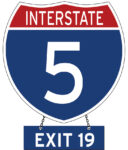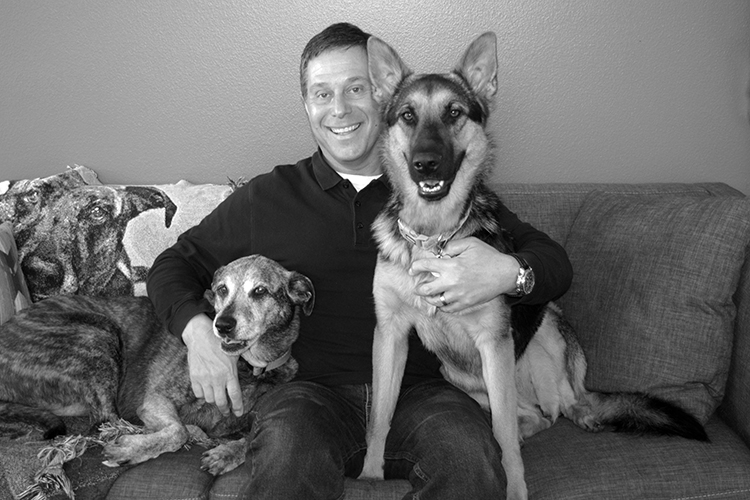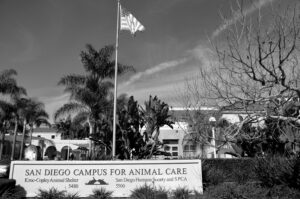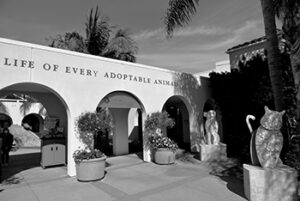 Editor’s Note: Last July 24, the last chapter in the first volume of Editor Emeritus Donald H. Harrison’s ‘Schlepping and Schmoozing Along the Interstate 5’ was republished. The chapter concerned the San Diego County Sheriffs Museum located in Old Town San Diego. With this issue, and on Sundays thereafter, we begin republication of the 60 chapters total in Volumes 2 and 3 of the book, which is available in its three-volume entirety on www.Amazon.com. This chapter, concerning the San Diego County Humane Society, is the first chapter in ‘Schlepping and Schmoozing Along the Interstate 5, Vol. 2: Morena District Through the San Diego County Fairgrounds.”
Editor’s Note: Last July 24, the last chapter in the first volume of Editor Emeritus Donald H. Harrison’s ‘Schlepping and Schmoozing Along the Interstate 5’ was republished. The chapter concerned the San Diego County Sheriffs Museum located in Old Town San Diego. With this issue, and on Sundays thereafter, we begin republication of the 60 chapters total in Volumes 2 and 3 of the book, which is available in its three-volume entirety on www.Amazon.com. This chapter, concerning the San Diego County Humane Society, is the first chapter in ‘Schlepping and Schmoozing Along the Interstate 5, Vol. 2: Morena District Through the San Diego County Fairgrounds.”

Schlepping and Schmoozing Along the Interstate 5: Exit 19 (Old Town Avenue): San Diego County Humane Society
From northbound I-5, take the Old Town Avenue exit, turn right onto Hortensia Street. At San Diego Avenue turn left and follow to a right turn on Taylor Street. Turn left onto Morena Blvd. and bear right making a right turn on Riley Street. Gaines Street is on the left. The Humane Society is at 5500 Gaines Street.
By Donald H. Harrison

SAN DIEGO — Gary Weitzman, the president and CEO of the San Diego Humane Society, once had flirted with the idea of becoming a rabbi. Why not? His family had a history of involvement in Jewish life: his grandfather’s cousin was Chaim Weizmann, the first president of Israel. While growing up in Natick, Massachusetts, the spiritual leader who was the most influential in Weitzman’s life was Rabbi Harold S. Kushner of Temple Israel, the author of When Bad Things Happen to Good People. That book was prompted by the death of Kushner’s son Aaron, who suffered from the rapid aging disease of progeria. About the time Weitzman had his bar mitzvah, Aaron, a contemporary, died. “It was tragic and horrifying.”
A love for animals exercised the strongest pull on young Weitzman. Reading before kindergarten, he was impressed by James Herriot’s All Creatures Great and Small, and “I had a ton of pets, but I wanted a dog, and my parents wouldn’t let me,” he recalled. “So, instead I had 50 gerbils, a dozen hamsters, a parakeet, an iguana, chameleon, rabbits, and guinea pigs. I filled the house with small animals. They finally acquiesced. I got my first dog.” Weitzman said his parents, Myrna and Laurence, contended having a dog would be too much responsibility and too much work. “It became kind of a trope in my family that my father would always say ‘No, I don’t want a dog.’ Guess who fell most in love with that dog?” Yes, it was his father. Today, his father “is the biggest dog lover.” Big but not necessarily the biggest. When his parents finally relented and let the 16-year-old Weitzman have a long-haired chow-shepherd mix named Cocoa, a “fantastic, absolutely beautiful dog, I think that dog was my mother’s love of her life.” Recently, when his parents decided to move to a local retirement community, they made sure the one they chose permitted residents to keep pets.

A visit in December 2021 to Weitzman’s office at San Diego Humane Society indicated that Weitzman, himself, may be the biggest dog lover in the family. “Rosie,” a young German Shepherd, and “Betty” an elderly Pit Bull mix, were ensconced on side-by-side sleeping mats located between his desk and a couch. Rosie enthusiastically greets visitors, perhaps believing the real purpose of their visit is to see her. She eventually settles down, taking her place alongside Betty’s mat. Betty looks up and sighs, as if to say, “She’s a puppy, what can you do?” and placidly closes her eyes again.
I asked Weitzman, who is a doctor of veterinary medicine, how the Covid pandemic impacted the work of San Diego Humane Society, which in addition to San Diego has facilities in El Cajon, Escondido, Oceanside, and Ramona and is looking for property in the South Bay.
He responded that during 2020, “shelters throughout the United States saw a massive drop in animal intake, so much so that the ones who were there were adopted immediately. Animals did not stay in any shelter very long because they went to homes.” The year 2021, he said, “was more normal–the numbers were about 40 percent higher.”
Unlike previous years when San Diego Humane Society would rescue many strays, in 2020 most people “weren’t losing their animals during Covid; they stayed with them. We have more than five dozen officers on the streets, but they weren’t picking them up during Covid because the animals were safely at home. That led to about a 50 percent decrease from the animals we saw in 2019.”
As the world thought it was recovering from the pandemic, until news of the new Omicron strain came in November 2021, the number of strays doubled. Throughout California there was a “huge jump in the number of small animals like hamsters, guinea pigs, and rabbits” that were being brought to the Humane Society. “We’ve never seen numbers for small animals like this before,” Weitman said. On the day of our interview, he reported, “we have 205 small animals here right now, whereas we normally have about 60. At one point there were 400 at our San Diego campus alone.” Additionally, he said, “we are getting a lot of dogs and cats that are being surrendered.”
Weitzman said the data still was being analyzed to explain why that was happening, but of one thing he was certain: “This is not just in San Diego; there is a national trend.” Perhaps, he suggested, a lot of people are suffering “compassion fatigue” in the wake of Covid.
When Weitzman took over the reins of San Diego Humane Society ten years ago, it was a much smaller operation, handling approximately 3,000 to 4,000 animals a year. Now the volume of animals is more than ten times as great, approximately 45,000–most of them being dogs and cats.
I asked Weitzman if he’s seen any interesting trends among the various pet populations.
Over the last three to four years, he answered, there has been an increase in the phenomenon of “community cats,” which are cats that have no specific owners, but which are taken care of by various members of the community in which they live.”
“Lots of people own cats that go outside,” he said. “For their safety, we’d rather that they stay inside because there are automobiles, coyotes, and other dangers outdoors. But the fact of the matter is that cats love to be outside and you can’t always keep them inside. We are seeing animal services in general ease up on the edict that all cats need to live in houses. Many thrive outdoors and do so successfully in nearly all countries in the world. The world has changed, of course, so we still advise people if they are going to adopt a cat, to keep the cat indoors safe and sound. But the fact of the matter is maybe taking a cat that is thriving outside and bringing him to an animal shelter and adopting him to someone else, may not be the answer.”

Cats taken in off the street and not adopted could become sick in shelters. San Diego Humane Society is able to provide medical care for them but other shelters in the United States may not be able to provide that care. So, “for us, here, we think it is wrong to take them in when they are doing well, when they are safe and sound. We spay and neuter them, treat them for minor medical issues they may have, and then get them out to where they were found, if they are doing well and the community is taking care of them.”
ABC 10News reported in March 2022, three months after my interview with Weitzman, that attorney Bryan Pease has brought a lawsuit against the Humane Society seeking to end the release of cats onto the street. He told news anchor Kimberly hunt that the policy “constitutes an illegal animal abandonment.” Dawn Danielson, a former director of the San Diego County Department of Animal Services, commented, ” the main reason the practice of releasing cats is being taught now to shelters is to make their numbers look good. The shelters can brag how they didn’t have to euthanize any cats. But what they are not saying is these cats are being dumped back on the streets and will likely suffer and die in some horrific manner. This practice is cruel, inhumane, and should stop immediately.”
In response, attorneys for San Diego Humane Society stated in court documents that the society’s activities “are indisputably motivated by humane principles and intended to enhance the welfare of the animals in question.”
During our interview, Weitzman commented that San Diego Humane Society is dedicated to the principle that “no healthy or treatable animal will ever be euthanized” — a pledge made in 2015 which was joined by the San Diego Animal Welfare Coalition. Weitzman said there are only three reasons why animals would be euthanized: 1) if the animal is irredeemably suffering; 2) if it has a disease that cannot be cured or managed; 3) if it is behaviorally dangerous enough to itself or others that it can’t be placed. He said that about 92 percent of the animals that come to San Diego Humane Society either go to another home or are returned to their owners.
Another trend, Weitzman said, is the influx of difficult-to-place animals such as pit bulls because there is a misconception that they are typically dangerous. “In most urban environments, San Diego included, we have a lot of pit bulls in our inventory,” Weitzman said. “They had a great reputation in the 1930s when they were the nanny dogs. They took care of children; they loved people. But now they do not always have the best reputation. I have one and I love them; they can become fantastic pets. They are not the dog that bites the most; that would probably be the chihuahua, but when they do bite it causes damage because they are so big.”
San Diego Humane Society plans to open a pet hospital for needs-based clients — that is, for those who cannot afford to bring their animals to regular veterinarians. It also has a Behavior Center, which can address behavior problems such as shy and fearful dogs, stressed cats, leash aggression, and other behavioral issues.
Asked how the private veterinary community would react to the creation of such facilities by his non-profit organization, Weitzman responded: “Ten years ago, they might have objected strongly. But I think now our private veterinarian community is so supportive of our mission and is such a partner in what we are doing, I don’t think there will be any objections. The population that we are serving is not necessarily the population that is going to them. So, it is ‘don’t treat or euthanize the animal’ or ‘let us treat them and keep them securely in their homes.'”
Weitzman is a strong advocate for removing barriers for people to have pets. He would like to see fewer restrictions against pet ownership at apartment houses and other rental properties, especially when the cost of housing makes private home ownership out of reach for many.
Similarly, he said, safe houses that offer shelter to survivors of domestic violence ought to reexamine any policies that prevent survivors from bringing their pets with them “A lot of people are afraid to go to shelters because they have a dog or a cat,” Weitzman said. “The best situation would be to have people safely housed with their pets. The City of Carlsbad is a great example of one of our regional cities taking a progressive look at emergency sheltering and we are partnering with them to provide emergency boarding.”
Weitzman also notes that “we have a huge homeless population, not the largest in the country, but it is difficult to see this and not have some heartbreak over this. A lot of homeless people have pets, so I want to give them the care they need both for themselves and for their pets. That’s a big priority for San Diego Humane Society.”
In a transborder initiative, San Diego Humane Society plans to launch a program to provide medical care for pets in Tijuana. “We want to be in Baja to make sure street dogs have the basics to stay healthy and comfortable. San Diego is the only community with the resources to do this for our sister city across the border and we are happy to provide that assistance.”
*
Author Donald H. Harrison is editor emeritus of San Diego Jewish World. Next Week: Exit 21 (Sea World Drive): Hubbs Sea World Research Institute.